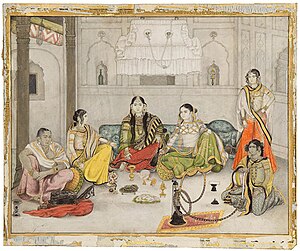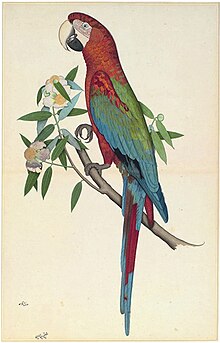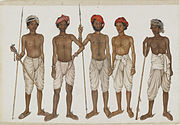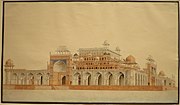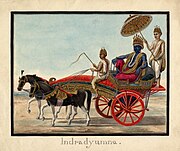Company style
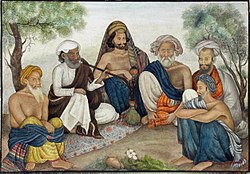
Company style or Company painting (kampani kalam in Hindi) is a term for a hybrid Indo-European style of paintings made in India by Indian artists, many of whom worked for European patrons in the British East India Company or other foreign Companies in the 18th and 19th centuries. The style blended traditional elements from Rajput and Mughal painting with a more Western treatment of perspective, volume and recession. Most paintings were small, reflecting the Indian miniature tradition, but the natural history paintings of plants and birds were usually life size.
Locations[edit | edit source]
Leading centres were the main British settlements of Calcutta, Madras (Chennai), Delhi, Lucknow, Patna, the Maratha court of Thanjavur and Bangalore. Subjects included portraits, landscapes and views, and scenes of Indian people, dancers and festivals. Series of figures of different castes or trades were particular favourites, with an emphasis on differences in costume; now they are equally popular as subjects for analysis by historians of the imperialist mentality. Portfolios of animal or botanical subjects were also commissioned, and some erotic subjects. Architectural subjects were popular, usually done in a detailed and frontal style more like that of an architectural draftsman than the Romanticised style used by most European painters visiting India. The techniques varied, but mostly drew on Western watercolour technique, from which "transparency of texture, soft tones and modelling in broad strokes" were borrowed.[1]
Patrons and artists[edit | edit source]

Large-scale patrons included Colonel James Skinner of Skinner's Horse fame, who had a Rajput mother, and for natural history paintings, Mary Impey, wife of Elijah Impey, who commissioned over three hundred, and the Marquess Wellesley, brother of the first Duke of Wellington, who had over 2,500. There were equivalent movements, but much smaller, around the French and Portuguese possessions in India, and in other South Asian areas like Burma and Ceylon.
The French-born Major-General Claude Martin (1735–1800), latterly based in Lucknow, commissioned 658 paintings of birds, including Black Stork in a Landscape, now in the Metropolitan Museum of Art in New York.[2]
Some notable artists include Mazhar Ali Khan, who worked on Thomas Metcalfe's Delhi Book, and was part of a dynasty of miniature artists, the patriarch of whom, Ghulam Ali Khan, had worked for William Fraser on a similar commission known as the Fraser Album, considered a masterpiece. He, like his uncle Ghulam Murtaza Khan, also painted portraits of the last Mughal emperors and their courts.
Material[edit | edit source]
Paintings were mostly on paper, but sometimes on ivory, especially those from Delhi. They were mostly intended to be kept in portfolios or albums; the muraqqa or album was very well established among Indian collectors, though usually including calligraphy as well, as least in Muslim examples. The style developed in the second half of the 18th century, and by the early nineteenth century production was at a considerable level, with many of the cheaper paintings being copied by rote. By the 19th century many artists had shops to sell the work and workshops to produce it.
Decline[edit | edit source]
The arrival of photography was a direct blow for the style, but it survived into the 20th century, Ishwari Prasad of Patna, who died in 1950, being perhaps the last notable exponent. In the late 19th century the British established several Schools of Art, where a yet more Westernised version of the style was taught, later in competition with other styles.
East India Company official and servants, perhaps William Fullerton of Rosemount, surgeon and mayor of Calcutta in 1757
Akbar's Tomb at Sikandra, Sheikh Latif, c. 1810-1820
Indradyumna in a carriage, early 19th century
References[edit | edit source]
- ↑ Linda Leach in George Mitchell (ed.), In the Image of Man, The Indian Perception of the Universe through 2000 years of painting and sculpture, Royal Academy of Arts, London, 1982, ISBN 0-7287-0311-4
- ↑ "Black Stork in a Landscape". The Metropolitan Museum of Art, i.e. The Met Museum. Retrieved 25 May 2018.
Further reading[edit | edit source]
- Archer, Mildred and William G., Indian Painting for the British, 1770–1880 (1955)
- Archer, Mildred. Company Paintings: Indian Paintings of the British Period. London: Victoria and Albert Museum, 1992. ISBN 0944142303.
- Welch, Stuart Cary. Room for Wonder: Indian Court Painting during the British Period, 1760–1880. Exhibition catalogue. New York: American Federation of Arts, 1978. ISBN 0847801764.
- Kossak , Steven (1997). Indian court painting, 16th-19th century.. New York: The Metropolitan Museum of Art. ISBN 0870997831. (see index: p. 148-152)
